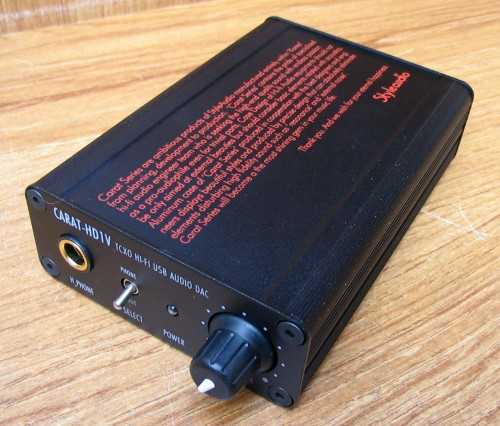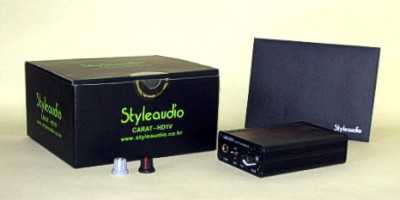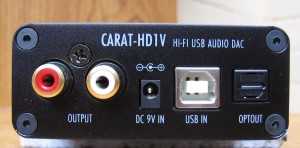

Product: Styleaudio Carat-HD1V USB DAC
Manufacturer: Styleaudio
Cost: 130 UK pounds (YMMV) .
Reviewer: Nick Whetstone - TNT UK
Reviewed: May, 2008
Storing music on a hard drive, and using a computer to play it back is now commonplace. While some folks still rely on the internal sound-card, others look for an external solution, either because they don't want to open up their computer and install a better sound-card, or they don't want the sound processing done in the mechanically and electrically noisy environment inside the computer. That's the reason for the increasing popularity of the USB DAC! I first experienced a USB DAC when I reviewed the Trends UD-10 back in December 2006. Here we will take a look at the Styleaudio Carat HD1V USB DAC from Korea.
The Carat-HD1V certainly made a good impression when it arrived in the post! The outer packaging was sealed with packaging tape that had piano keys printed on it. The inner box, containing the DAC was no less impressive in its black colour with green printing. Opening the box I found a black envelope with 'Styleaudio' embossed in silver, containing the instructions for using the DAC. The DAC itself, is also black, thinner than the Trends UD-10 (but with the same footprint), and looks very classy. Internally, the Carat boasts a similar line-up of audiophile components to the Trends UD-10: Oscon and Wima capacitors, and Dale precision resistors sit proudly on the compact (yes, you guessed it, black) PCB. Such is the thought put into the presentation of the HD1V, you even get three different coloured knobs for the headphone volume adjustment. So does the performance match the looks?

I hooked the Carat-HD1V up to a PC running Ubuntu, and using 'Banshee' to play the music. I've said it before but it's worth repeating, I prefer this set-up for playing music than the Windows XP/Winamp/ASIO drivers set-up. I decided to start off listening through headphones and got out my Sennheiser PX100's. I then had to hunt out my adaptor, as the Carat features a 6.35mm jack socket for the headphone connection, while my PX100's have a 3.5mm plug. If you are thinking of buying the Carat (or a similar device), check that it has the same size socket as your headphones, and if not, make sure you get hold of a suitable adaptor.
I listened to a variety of music through the Carat/Sennheiser combination but even with the volume control on the DAC set to maximum, it was only just loud enough. I did try listening through some older Pioneer headphones but the result was just the same. (I also tried listening on another PC using XP/ASIO). I double-checked that there wasn't a problem with my set-up but there wasn't and a quick Google brought up another review of this item that confirms my findings. I would imagine something like the Carat would often be used with headphones, so the maximum volume level is an issue. That said, I got out the Trends UD-10, and tried it with the headphones and the output level was the same. At least you are not likely to damage your hearing listening to these DAC's through headphones. And it must also be said that the quality of sound through the headphones was very good.

The Carat is supplied without a power supply unit, instead taking its power from the PC via the USB connection. Styleaudio took the decision not to include a PSU because they felt that anybody wanting to take the Carat to a higher level of performance would want to choose their own PSU, and it kept the cost of the unit down by not supplying one. As it is also more environmentally more friendly not to send one (better still thousands) all over the world, I think their policy is admirable. As Styleaudio told me, many people already have some sort of 9 volt PSU, and indeed I had an old modem PSU in my parts box that I was able to press into action.
Unfortunately, although the separate PSU improved sound qulaity by quite a bit, the separate supply did nothing to increase the output level through the headphones, so I hooked up a class-T amplifier, and a pair of small speakers to try with the Carat. I much preferred listening to the Carat via the amp and speakers, and sound quality was very good. It wouldn't do for a party, but for desktop listening it is plenty loud enough. I would put it on a par with the Trends UD-10, and it will certainly out-perform the typical internal sound-card found in most PC's! You should note as well that although the headphone volume can be controlled by the pot in the Carat, the line out will require some method of adjusting the volume level (if you can't control it via the PC).
There are quite a lot of these USB DAC's on the market now. A comparison with the Trends UD-100 is worthwhile although their prices are different. In the UK, the Carat can be bought for 130 pounds, while the Trends (from the same supplier) is only 90 pounds. The Trends has more options for connecting an external DAC (if you need them) while the Carat is limited to an optical digital connection. But the Carat has a volume control for the headphones (although in practice it is hardly needed). The Carat does sport a pair of RCA phono connectors for the line out compared to the 3.5mm jack socket on the UD-10. I prefer the looks of the more compact black Carat DAC but I am not sure if I would ever buy audio equipment based on its looks. But I guess the typical buyer of this sort of item could be swayed by appearance. Sound quality is too close to say that one of these DAC's is better than the other, and for me, the price difference would have me favouring the Trends UD-10.
In conclusion, the Carat-HD1V USB DAC works well as an upgrade from an internal card (although I would have liked a bit higher level through the headphones). It looks good, which may be important to some, and isn't too expensive, although there are cheaper options like the Trends UD-10. However, I do strongly advise the use of an external PSU with the Carat. It's only with an external PSU that the sound quality improves noticeably over the internal sound-card.
© Copyright 2008 Nick Whetstone - www.tnt-audio.com